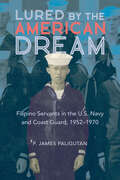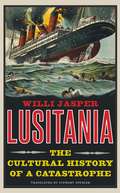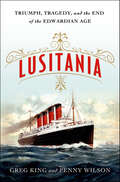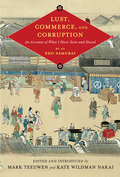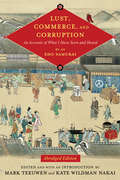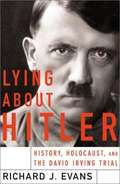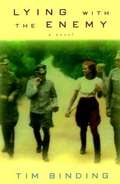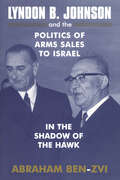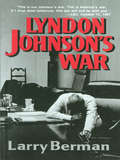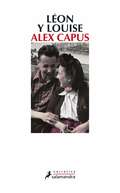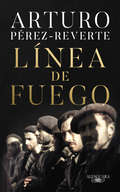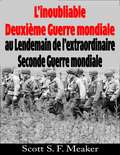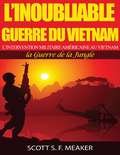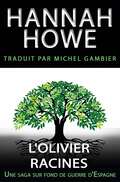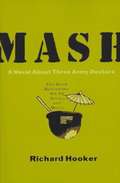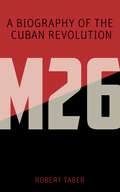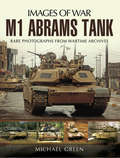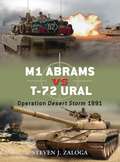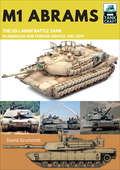- Table View
- List View
Lured by the American Dream: Filipino Servants in the U.S. Navy and Coast Guard, 1952-1970 (Asian American Experience)
by P. James PaligutanStarting in 1952, the United States Navy and Coast Guard actively recruited Filipino men to serve as stewards--domestic servants for officers. Oral histories and detailed archival research inform P. James Paligutan's story of the critical role played by Filipino sailors in putting an end to race-based military policies. Constrained by systemic exploitation, Filipino stewards responded with direct complaints to flag officers and chaplains, rating transfer requests that flooded the bureaucracy, and refusals to work. Their actions had a decisive impact on seagoing military’s elimination of the antiquated steward position. Paligutan looks at these Filipino sailors as agents of change while examining the military system through the lens of white supremacy, racist perceptions of Asian males, and the motives of Filipinos who joined the armed forces of the power that had colonized their nation. Insightful and dramatic, Lured by the American Dream is the untold story of how Filipino servicepersons overcame tradition and hierarchy in their quest for dignity.
Lusitania: The Cultural History of a Catastrophe
by Willi Jasper Mr Stewart SpencerA fascinating reassessment of a turning point in the First World War, revealing its role in shaping the German psyche On May 7, 1915, the Lusitania, a large British luxury liner, was sunk by a German submarine off the Irish coast. Nearly 1,200 people, including 128 American citizens, lost their lives. The sinking of a civilian passenger vessel without warning was a scandal of international scale and helped precipitate the United States' decision to enter the conflict. It also led to the immediate vilification of Germany. Though the ship's sinking has preoccupied historians and the general public for over a century, until now the German side of the story has been largely untold. Drawing on varied German sources, historian Willi Jasper provides a comprehensive reappraisal of the sinking and its aftermath that focuses on the German reaction and psyche. The attack on the Lusitania, he argues, was not simply an escalation of violence but signaled a new ideological, moral, and religious dimension in the struggle between German Kultur and Western civilization.
Lusitania: Triumph, Tragedy, and the End of the Edwardian Age
by Greg King Penny WilsonOn the 100th Anniversary of its sinking, King and Wilson tell the story of the Lusitania's glamorous passengers and the torpedo that ended an era and prompted the US entry into World War I.Lusitania: She was a ship of dreams, carrying millionaires and aristocrats, actresses and impresarios, writers and suffragettes – a microcosm of the last years of the waning Edwardian Era and the coming influences of the Twentieth Century. When she left New York on her final voyage, she sailed from the New World to the Old; yet an encounter with the machinery of the New World, in the form of a primitive German U-Boat, sent her – and her gilded passengers – to their tragic deaths and opened up a new era of indiscriminate warfare.A hundred years after her sinking, Lusitania remains an evocative ship of mystery. Was she carrying munitions that exploded? Did Winston Churchill engineer a conspiracy that doomed the liner? Lost amid these tangled skeins is the romantic, vibrant, and finally heartrending tale of the passengers who sailed aboard her. Lives, relationships, and marriages ended in the icy waters off the Irish Sea; those who survived were left haunted and plagued with guilt.Authors Greg King and Penny Wilson resurrect this lost, glittering world to show the golden age of travel and illuminate the most prominent of Lusitania's passengers. Rarely was an era so glamorous; rarely was a ship so magnificent; and rarely was the human element of tragedy so quickly lost to diplomatic maneuvers and militaristic threats.
Lust, Commerce, and Corruption: An Account of What I Have Seen and Heard, by an Edo Samurai (Translations from the Asian Classics)
by Anne Walthall Kate Wildman Nakai John Breen Trans. Eds. Teeuwen Mark Fumiko UmezawaBy 1816, Japan had recovered from the famines of the 1780s and moved beyond the political reforms of the 1790s. Despite persistent economic and social stresses, the country seemed to be approaching a new period of growth. The idea that the shogunate would not last forever was far from anyone's mind.Yet, in that year, an anonymous samurai author completed one of the most detailed critiques of Edo society known today. Writing as Buyo Inshi, "a retired gentleman of Edo," he expresses a profound despair with the state of the realm and with people's behavior and attitudes. He sees decay wherever he turns and believes the world will soon descend into war.Buyo shows a familiarity with many corners of Edo life that one might not expect in a samurai. He describes the corruption of samurai officials; the suffering of the poor in villages and cities; the operation of brothels; the dealings of blind moneylenders; the selling and buying of temple abbotships; and the dubious strategies townspeople use in the law courts. Perhaps the frankness of his account, which contains a wealth of concrete information about Edo society, made him prefer to remain anonymous.This volume contains a full translation of Buyo's often-quoted but rarely studied work by a team of specialists on Edo society. Together with extensive annotation of the translation, the volume includes an introduction that situates the text culturally and historically.
Lust, Commerce, and Corruption: An Account of What I Have Seen and Heard, by an Edo Samurai, Abridged Edition (Translations from the Asian Classics)
by Kate Wildman Nakai Mark TeeuwenBy 1816, Japan had recovered from the famines of the 1780s and moved beyond the political reforms of the 1790s. Despite persistent economic and social stresses, the country seemed headed for a new period of growth. The idea that the shogunate would not last forever was far from anyone's mind.Yet, in that year, an anonymous samurai produced a scathing critique of Edo society. Writing as Buyo Inshi, "a retired gentleman of Edo," he expressed in An Account of What I Have Seen and Heard a profound despair with the state of the realm. Seeing decay wherever he turned, Buyo feared the world would soon descend into war.In his anecdotes, Buyo shows a sometimes surprising familiarity with the shadier aspects of Edo life. He speaks of the corruption of samurai officials; the suffering of the poor in villages and cities; the operation of brothels; the dealings of blind moneylenders; the selling and buying of temple abbotships; and the dubious strategies seen in law courts. Perhaps it was the frankness of his account that made him prefer to stay anonymous.A team of Edo specialists undertook the original translation of Buyo's work. This abridged edition streamlines this translation for classroom use, preserving the scope and emphasis of Buyo's argument while eliminating repetitions and diversions. It also retains the introductory essay that situates the work within Edo society and history.
Luxury Fleet: The Imperial German Navy 1888-1918
by Holger HerwigThis book reviews the building of the German Imperial navy from a small coastal defense fleet to the world's second largest navy by the First World War. The term "Luxury Fleet" (as coined by Winston Churchill) denotes British view of the German navy as a luxury while the British navy was vital to its existence. This dichotomy is detailed in the monograph and the rivalries that ensued.
Lying About Hitler: History, Holocaust and the David Irving Trial
by Richard J. EvansTo those who argue that the London court's 2000 ruling against Holocaust denier Irving threatens to silence legitimate historians' questions on the Nazi extermination of Jews, the Cambridge U. specialist on modern German history who was the principal expert witness for the defense (of Deborah Lipstadt for libel) says, in effect, rubbish. Evans explains how Irving's "analysis" distorts the historical record to serve his revisionist agenda.
Lying with the Enemy
by Tim BindingIn 1943, 145,000 Germans had been slaughtered in Stalingrad. The tide of the war was beginning to turn. But not on the quiet, idyllic island of Guernsey, the only British territory to be occupied by German troops in the Second World War. Here Nazi officers still party with local girls, love affairs blossom, and the amateur dramatic society continues to stage its theatricals, if with suspiciously jackbooted pirates in Peter Pan. Then the body of a young woman, her nose and mouth filled with cement, turns up, and the comedy of manners played out by the collaborators and their captors turns sour. Food becomes scarce, facades of civility crack, the skies over Guernsey darken, and the search for a killer unearths horrors shared by the islanders and the enemy alike.
Lyndon B. Johnson and the Politics of Arms Sales to Israel: In the Shadow of the Hawk (Israeli History, Politics And Society Ser.)
by Abraham Ben-ZviLyndon B. Johnson and the Politics of Arms Sales to Israel seeks to reconstruct and elucidate the processes behind the decisions made by the Johnson Administration during the years 1965-68 to sell Israel M-48 tanks, A-4 Skyhawk planes and F-4 Phantom planes. This examination is based on a distinction between three factions which competed for influe
Lyndon Johnson's War: The Road to Stalemate in Vietnam
by Larry Berman"Stunning....The portrait of the embattled and unyielding president that emerges is vivid and memorable."--Publishers Weekly By 1968, the United States had committed over 525,000 men to Vietnam and bombed virtually all military targets recommended by the joint Chiefs of Staff. Yet, the United States was no closer to securing its objectives than it had been prior to the Americanization of the war. The long-promised light at the end of the tunnel was a mirage. This absorbing account reveals the bankruptcy of the bombing campaign against North Vietnam, the failures of political reform in South Vietnam and the bitter bureaucratic conflicts between the US government and its military commanders.
Lágrimas del sol naciente dorado: perspectiva de testigo ocular en la historia de Biafra
by Ikechukwu JosephPero Emily se despertó en una granja abandonada. Parecía más somnolienta y adormilada. Ella no podía reconocerse a sí misma. Todo lo que podía escuchar eran los cantos de las ranas toro y la correspondiente respuesta más ligera de su contraparte femenina. Sándwich en el medio estaban las bocinas de vehículos distantes. Emily se durmió de nuevo como un tronco. El sueño era tan dulce ahora. El sedante no solo indujo el sueño, sino que también tuvo un efecto calmante y calmante. Ya estaba amaneciendo con adoradores del sol y pájaros del sol haciendo lo suyo cuando la pobre Emily se despertó. Todavía estaba cansada y aturdida. "¡Hola! ¡Hola! ¿Hay alguien ahí?" Trató de levantarse pero sus manos y piernas estaban atadas a la silla. Aterrada, gritó, pero nadie pudo oírla. Al mirar por la ventana vio un sedán rojo aparcado en lo que parecía la parte trasera del corral. Emily luchó por liberarse, pero estaba muy débil. El efecto de los sedantes. Miró a su alrededor y vio una pistola a un lado de la habitación. Ha pasado mucho tiempo que vio uno desde que escapó de la zona de guerra. Su fuerte voluntad luchó contra el pánico en su voz. "Bebé, ¿estás despierto?" Una voz ronca se acercó por detrás y tocó su cuello, masajeando. Emily se estremeció al recordar todas las historias tanto de MM como de las novelas. El violador en serie, los secuestradores y ritualista. "¿Pero qué hice?" Miró al anciano con cabello gris y ojos llameantes. "Bebé, tienes que comer para tener fuerzas para luchar contra tus enemigos ..." Cuando Angelo abrió una de las pilas de bolsas, algo que parecía un hueso humano se cayó. Lo besó y se rió histéricamente murmurando palabras como "su carne era muy dulce, dulce señora, su esposo debe haberte extrañado. Espero que Dios me dé otro como tú que rompa la regla número uno". Entonces Emily se dio cuenta de que había sido presa de un caníbal humano. Rezó todas las oraciones, pero parecía no tener
Léon y Louise
by Alex CapusExquisita por su ligereza y conmovedora por su intensidad, la verosimilitud del relato sorprenderá al lector más avezado. Obra finalista del Deutscher Buchpreis -uno de los premios literarios de referencia en Alemania-, esta última novela de Alex Capus es la máxima expresión de una historia de amor que desafía todas las convenciones. El verano de 1918, la Primera Guerra Mundial está a punto de terminar, pero sus consecuencias perdurarán durante décadas. Para algunas personas, incluso toda una vida. Léon le Gall es un joven rebelde de apenas diecisiete años que ha decidido dejar los estudios y trabaja como ayudante en la estación ferroviaria de Saint-Luc-sur-Marne, en la costa de Normandía. Allí es donde conoce a la hermosa y esquiva Louise Janvier, y entre ellos surge un sentimiento puro, noble y profundo. Sin embargo, todo salta por los aires cuando Louise desaparece durante un bombardeo de la aviación alemana. Abatido porla pérdida, Léon logra reconstruir su vida. Se casa, tiene hijos y empieza a trabajar como científico para la policía, pero nunca conseguirá olvidar a Louise. La crítica ha dicho...«Entre todas las parejas de enamorados, felices o infelices, que nos ha presentado la literatura, la de Léon y Louise es una de las más originales y creíbles.»Süddeutsche Zeitung «El libro de esta primavera. Una historia maravillosa que deja un vacío cuando uno termina de leerla. Y que nos hace desear secretamente encontrar a alguien como Léon en la próxima vida. O a alguien como Louise.»WDR «La historia de un amor que se opone a la historia del mundo. Una pieza literaria finamente trabajada sobre el deseo de lograr la felicidad, sobre la conformidad y la supervivencia.»Tages-Anzeiger «Este libro elige a sus lectores. [...] Alex Capus ha escrito una fascinante historia de amor en circunstancias difíciles [...]. Una historia bellísima que lo es tanto por su estilo como por todo aquello que el lenguaje no puede describir.»Frankfurter Allgemeine Zeitung «A simple vista, ésta es una historia de un amor que perdura. Pero también habla de los abusos de poder, especialmente en tiempos de guerra, y de los sacrificios que el ser humano debe hacer para preservar aquello que más ama.»Publishers Weekly
Línea de fuego
by Arturo Pérez-ReverteLA NUEVA NOVELA DE ARTURO PÉREZ-REVERTE Julio de 1938, miles de jóvenes combaten en la trágica batalla del Ebro. Sus nombres no son los que recuerda la Historia, pero cuanto les sucedió forma parte de nuestra memoria. «Es lo malo de estas guerras. Que oyes al enemigo llamar a su madre en el mismo idioma que tú.» Durante la noche del 24 al 25 de julio de 1938, la XI Brigada Mixta del ejército de la República cruza el río para establecer una cabeza de puente en Castellets del Segre. En las inmediaciones del pueblo, medio batallón de infantería, un tabor marroquí y una compañía de la Legión defienden la zona. Está a punto de comenzar la batalla del Ebro, la máscruda y sangrienta que se libró nunca en suelo español. Combinando de forma magistral la ficción con datos históricos y testimonios personales, Arturo Pérez-Reverte sitúa al lector, con sobrecogedor realismo, entre quienes, voluntarios o a la fuerza, lucharon en los frentes de batalla de la Guerra Civil. Sus nombres no son los que recuerda la Historia, pero cuanto les sucedió resuena en estas páginas con el dramatismo de una memoria que nos pertenece a todos. Ésta no es una novela sobre la Guerra Civil, sino sobre los hombres y mujeres que combatieron en ella. La historia de los padres y abuelos de numerosos españoles de hoy. La crítica ha dicho:«La novela definitiva sobre la Guerra Civil española. [Un] proyecto literario inmenso, envolvente y, pese a la crudeza del relato, poderosamente fascinante por la trascendencia del momento en que nos sumerge.»Sergio Vila-Sanjuán, Cultura/s, La Vanguardia «Un libro asombroso, durísimo y brillante. Todo está ahí, todo en esas páginas escritas con un pulso y una habilidad endiabladas. Un libro para leer, para meditar y al que hay que volver. Línea de fuego es una obra maestra, una catedral literaria y la mejor novela de Arturo Pérez-Reverte.»Juan Gómez-Jurado, El Correo «La batalla del Ebro fue emblemática [...]. Allí ha recalado Pérez-Reverte con la cámara de sus ojos y calidad de su escritura para decirnos que el horror y la piedad, la sinrazón y el heroísmo no son ideas, son vida y cuerpos, que necesitaban de un gran novelista que supiera contarlos.»José María Pozuelo Yvancos, ABCultural «Un relato épico del mejor novelista de nuestro tiempo.»Raúl del Pozo, El Mundo «680 páginas hipnóticas, intensas en emoción y humanidad.»Javier Ors, La Razón «Hay mucha más verdad histórica en Línea de fuego que en la Historia que nos quieren contar los políticos.»Julia Navarro «No va a dejar a nadie indiferente. Sabe de lo que habla, y ha sabido contarlo.»Jesús García Calero, ABC «Una novela de madurez sobre el desconcierto, el desamparo y el miedo.»Antonio Lucas, El Mundo «Línea de fuego, en fin, es una gran novela, muy española, justo cuando ya no sabemos qué es lo español.»Alberto Olmos, El Confidencial «Inmensa, estremecedora e imprescindible. Una obra que se asoma y se adentra hasta el corazón de la peor tragedia vivida en los últimos siglos por nuestra patria y nuestras gentes. [...] Una novela de hueso y carne viva. Sin grasa. Es un Arturo Pérez Reverte en su más espléndida madurez literaria despojada más todavía que nunca de condicionantes.»Antonio Pérez Henares, El Día de Valladolid «Pérez-Reverte nos regala una obra maestra que se adentra en la Guerra Civil española [...] para darnos una quintaesencia no solo del choque sino del alma fratricida de todala
L’inoubliable Deuxième Guerre mondiale: au Lendemain de l’extraordinaire Seconde Guerre mondiale
by Hanène Baatout Scott S. F. Meaker*** Ceci est un petit ouvrage qui se focalise sur le lendemain de l'extraordinaire Seconde Guerre mondiale *** La guerre a la tradition de changer la carte sociale et économique d'un pays. Le concept de famille a été complètement déchiré avec la dévastation généralisée de la Seconde Guerre mondiale. Ce livre se penche sur les expériences de six personnes provenant de divers secteurs impliqués dans ce conflit mondial - à la suite de l'extraordinaire Seconde Guerre mondiale.
L’inoubliable Guerre du Vietnam: l’Intervention militaire américaine au Vietnam – la Guerre de la Jungle
by Hanène Baatout Scott S. F. MeakerNote: ***** Ceci est un petit ouvrage portant sur la guerre du Vietnam. ***** La guerre du Vietnam a été menée comme une guerre et elle s'est terminée avec chacune des deux parties croyant être les vainqueurs. Mais cette guerre n'a pas commencé avec une déclaration de guerre officielle. Le nombre de luttes pour le pouvoir qui font partie de la toile vietnamienne est presque écrasant. Les batailles étaient courtes et intenses et ont été menées dans la jungle et les rizières. Une grande partie de la guerre a impliqué des attaques de guérilla.
L’olivier: Racines (L’olivier #1)
by Hannah HoweL’olivier, une saga sur fond de guerre civile espagnole Se déroulant entre avril 1937 et décembre 1938, L’olivier est une mini-série de cinq mini-romans basée sur des événements réels. Les cinq tomes — Racines, Branches, Feuilles, Fruit et Fleurs — retracent les vies d’Heini Hopkins, une jeune infirmière d’un coin misérable du sud du Pays de Galles, et de Naomi Parker, une riche écrivaine issue d’un milieu privilégié. Dans le premier tome, Racines, Heini est chez elle, au Pays de Galles, où elle s’occupe de sa mère malade, tandis que Naomi assiste à des soirées de lancement de son dernier roman. La guerre civile espagnole semble a des années-lumière, jusqu’à ce que les fascistes rasent Guernica en la bombardant, massacrant des centaines d’hommes, de femmes et d’enfants. Le petit copain d’Heini, Deiniol Price, un mineur, se demande s’il n’est pas de son devoir de rallier la cause des républicains espagnols et de se porter volontaire auprès des Brigades internationales tandis que l’amant de Naomi, le prince Nicolas Esteban, un pilote, rêve de gloire en combattant pour les fascistes. Nos deux femmes devraient-elles quitter la tranquillité du Pays de Galles pour les champs de bataille sanglants de l’Espagne ? Et si elles se décidaient à suivre leurs hommes, qu’est-ce que le destin leur réserve ?
M*A*S*H: A Novel About Three Army Doctors
by Richard HookerBefore there were the movie and the television series, there was the novel that gave birth to such American immortals as Hawkeye and Trapper John, Hot Lips Houlihan, Frank Burns, Radar O'Reilly, and the rest of the 4077th MASH--a place like no place else in Korea or on earth. The doctors and nurses who worked in the Mobile Army Surgical Hospitals (MASH) during the Korean War were well trained, dedicated, and pushed to the brink. And they were young--too young to be doing what they had to do. As Richard Hooker writes in the Foreword, "A few flipped their lids, but most of them just raised hell, in a variety of ways and degrees." Meet the true-life heroes and lunatics who fought in the Korean War, and experience the martini-laced mornings, marathon hijinks, sexual escapades, and that perfectly corrupt football game that every fan of the movie will remember. It's also a story of hard work and skill in the face of enormous pressure and odds. Here is where it all began--the novel that made M *A *S *H a legend.
M*a*s*h Goes To Paris
by Richard Hooker William E. ButterworthWhen HAWKEYE, king of the links and surgeon extraordinaire TRAPPER JOHN, bon vivant of the operating room and so good with his hands HOT LIPS, who's discovered... well... religion RADAR, with his great new idea for a fast-food empire and the rest of the lunatic crew from M*A*S*H hit the sin city on the Seine, the French had better look out! Things happen fast, funny and furious when the inimitable ambassadors of goodwill and goonery arrive, bringing inevitable chaos in their wake.
M-26: A Biography of the Cuban Revolution
by Robert TaberM-26: A Biography of the Cuban Revolution, first published in 1961, is a reporter’s account of the overthrow of the Batista regime and Fidel Castro’s successful rise to power. Author Robert Taber, a correspondent for CBS, details the political and economic situation which helped foster the revolution, plus chronicles events of the revolution and his experiences while living with the guerrilla fighters in Cuba’s mountainous interior. M26 (the name is from an earlier unsuccessful uprising—Movimiento Revolucionario—led by Castro in July, 1953) is a valuable resource for anyone seeking a well-written account of this critical period in Cuba’s history.
M.I.A.: Accounting for the Missing in Southeast Asia
by Paul D. MatherAmong the numerous analyses of those missing in action in Southeast Asia, this study is the first to concentrate on the process whereby the US military tried to resolve each case. Much of the continuing controversy ignores or refuses to accept the fact that the US Government, through the Joint Casualty Resolution Center and other mechanisms, has made a thorough, sustained, good faith effort to determine the fate of every serviceman declared missing in action in that conflict. The author, who spent more than 15 years in Southeast Asia taking part in those endeavors, tells the story of this unique effort from the point of view of an informed insider.A member of the MIA search team from the early 1970s through the late 1980s, Paul Mather is well qualified to relate the history of this effort. He covers a wide range of topics, from field work at crash sites and personal interchanges with Vietnamese, Cambodian, Lao, and Thai officials, through the various international accords that governed the activities of the US investigatory teams. Although political changes in the United States alternately facilitated or hampered search efforts, the attempt to resolve every case never ceased. Colonel Mather faithfully records the efforts of individuals and organizations that played major roles in. this drama: congressional committees; the National League of Families; private citizens who made sincere efforts to help; senior government officials like General John Vessey, who headed a special full-accounting commission; military agencies such as the Joint Casualty Resolution Center and the Army’s Central Identification Laboratory; scoundrels and swindlers who exploited the tragedy for personal gain; and self-styled Rambos who acted on their own.This account should help to wrap up an especially emotional chapter of the Vietnam War. By telling how the process worked for almost two decades, it contributes to the full accounting desired by all.
M1 Abrams Tank (Images of War)
by Michael GreenThis pictorial history of the legendary M1 Abrams Tank illustrates its versatility and advancement from the Cold War Era to the present day. The M1 Abrams has proved itself to be the finest main battle tank in the world since its introduction into US Army service in 1981. It combines the ultimate balance between firepower, mobility and protection as demonstrated by its superior performance during the two Gulf Wars and in Afghanistan. It routed the Soviet equipment of Saddam Hussein's army and today remains the yardstick by which friends' and foes' MBTs are judged. As military expert Michael Green demonstrates in this illustrated history, the M1&’s versatility, and its continual modernization of weaponry armor and engineering, guarantees that it will remain the US Army's spearpoint for years to come. With its comprehensive collection of images and authoritative text, this volume is an ideal resource for information on M1 Abrams Tank design and combat operations.
M1 Abrams vs T-72 Ural: Operation Desert Storm 1991
by Steven J. Zaloga Jim LaurierThe Gulf War bore witness to a number of deadly encounters between these two great adversaries. Heavily armored, highly mobile and capable of killing at over 2500m the M1 Abrams is, to this day, a veritable fighting machine. Superior to both Iraq's Soviet era T-55 and T-62 tanks, nearly all sources claim that no Abrams tank has ever been destroyed by enemy fire. Despite entering service in 1980, the M1 Abrams remained untested in combat until the Gulf War in 1991, where it was to be confronted by its archenemy the Iraqi-assembled Soviet-designed T-72. Entering production in 1971, the T-72 arguably outstripped its contemporaries in a balance of mobility, protection and firepower. By the time of Operation Desert Storm, however, the tables had turned and the tank suffered due to low quality ammunition and poorly trained crews. In this fascinating study, Steven Zaloga pits these two great fighting machines against one another, plotting the development of the Cold War until both tanks met in combat in the deserts of Iraq and Kuwait. From the Trade Paperback edition.
M1 Abrams: Rare Photographs From Wartime Archives (Images of War)
by David DoyleA photographic history of the principal main battle tank of the modern US military. Conceived to counter the threat of a massive Soviet armored incursion in Europe, the M1 Abrams tank gained considerable fame during the Persian Gulf War of 1991, and its combat record has continued to climb. With such a long service life, the Abrams has undergone continual improvements and upgrades, which are illustrated in great detail in this volume. The unique features of the various models are detailed in stunning color photos, and the combat use of these fearsome vehicles is richly illustrated through previously unpublished photos. The story of the Abrams begins in the late 1960s when the threat of Soviet Armor developments forced the U.S. to look for a suitable replacement for the M60 series. A joint venture between the U.S. and West Germany to build a suitable common Main Battle Tank brought about the unorthodox and terribly expensive MBT70. It never saw series production. When this program was cancelled in 1970, a quest for a more cost-effective tank was begun. The constant development, upgrade, and conversion of the series have kept the Abrams at the forefront of main battle tank technology—and it has proven itself on the battlefield time and time again. This book, filled with rare archival photos, takes us through decades of its remarkable history, including improvements to its armor, transmission, and engine; the addition of an integrated nuclear, biological, and chemical system; the installation of a layer of depleted uranium and interior blast doors to protect the crew, and more.
M1 Abrams: The US's Main Battle Tank in American and Foreign Service, 1981–2019 (Tank Craft)
by David GrummittA history of the iconic vehicle: &“This modeler's delight showcases the M1 and its variations with all sorts of camouflage schemes.&” —Historical Miniatures Gaming Society Since its introduction in 1981, at the height of the Cold War, the Abrams main battle tank has been one of the most visible symbols of American military power, and it is the fascinating subject of this heavily illustrated historical and modeling guide in the TankCraft series by David Grummitt. Designed to meet head-on the massed tank forces of the Warsaw Pact, its combat debut actually came in a different scenario in 1991, during the First Gulf War. Since then it has served in a peacekeeping role in the former Yugoslavia and seen combat in Iraq, Afghanistan, and Yemen. It has gone through a series of modifications and modernizations that see it set to remain the backbone of the US Army until at least 2050. As well as charting the development and combat history of the vehicle, this book is illustrated throughout with color photos and specially commissioned color profiles. Five different models, covering the service history of the Abrams, are featured, as is a modeler&’s guide to the existing kits and accessories in the all the popular scales.
M1 Abrams: The US's Main Battle Tank in American and Foreign Service, 1981–2019 (Tank Craft)
by David GrummittA history of the iconic vehicle: &“This modeler's delight showcases the M1 and its variations with all sorts of camouflage schemes.&” —Historical Miniatures Gaming Society Since its introduction in 1981, at the height of the Cold War, the Abrams main battle tank has been one of the most visible symbols of American military power, and it is the fascinating subject of this heavily illustrated historical and modeling guide in the TankCraft series by David Grummitt. Designed to meet head-on the massed tank forces of the Warsaw Pact, its combat debut actually came in a different scenario in 1991, during the First Gulf War. Since then it has served in a peacekeeping role in the former Yugoslavia and seen combat in Iraq, Afghanistan, and Yemen. It has gone through a series of modifications and modernizations that see it set to remain the backbone of the US Army until at least 2050. As well as charting the development and combat history of the vehicle, this book is illustrated throughout with color photos and specially commissioned color profiles. Five different models, covering the service history of the Abrams, are featured, as is a modeler&’s guide to the existing kits and accessories in the all the popular scales.
